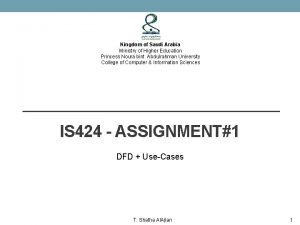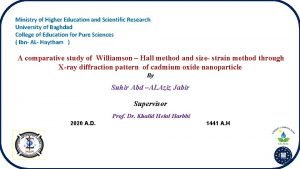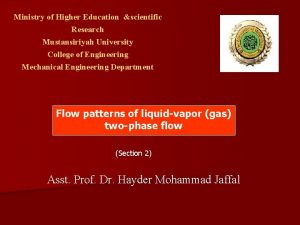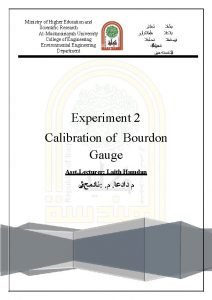Ministry of Higher Education scientific Research AlMustansiriya University

































- Slides: 33

Ministry of Higher Education &scientific Research Al-Mustansiriya University College of Engineering Energy management and applications Insulations (Section 3) Asst. Prof. Dr. Hayder Mohammad Jaffal

1 - Introduction Insulation materials are extensively used to reduce the heat losses (or gains) from thermal systems like buildings, pipes and ducts, components of HVAC installations, etc. Most mass-type thermal insulation materials are highly porous, and consist of a solid matrix full of small voids that comprise 90% or more of the total volume. These voids contain air or some other harmless gas such as CO 2. The apparent conductivity of the material is the macroscopic result of various basic heat transfer mechanisms: solid and gas conduction, gas convection and long-wave radiation within the voids. From the macroscopic point of view, the apparent conductivity mainly depends on the kind of insulation, bulk density, temperature, water content, thickness and age. From the microscopic point of view, factors such as cell size, diameter and arrangement of fibers or particles, transparency to thermal radiation or type and pressure of the gas come into play.

2 - Purpose of Insulation A thermal insulator is a poor conductor of heat and has a low thermal conductivity. Insulation is used in buildings and in manufacturing processes to prevent heat loss or heat gain. Although its primary purpose is an economic one, it also provides more accurate control of process temperatures and protection of personnel. It prevents condensation on cold surfaces and the resulting corrosion. Such materials are porous, containing large number of dormant air cells. Thermal insulation delivers the following benefits: 1 -Reduces over-all energy consumption 2 -Offers better process control by maintaining process temperature. 3 -Prevents corrosion by keeping the exposed surface of a refrigerated system above dew point.

4 -Provides fire protection to equipment 5 -Absorbs vibration

3 - Types and Application The Insulation can be classified into three groups according to the temperature ranges for which they are used. Low Temperature Insulations (up to 90 °C) This range covers insulating materials for refrigerators, cold and hot water systems, storage tanks, etc. The commonly used materials are Cork, Wood, 85% magnesia, Mineral Fibers, Polyurethane and expanded Polystyrene, etc. Mineral Fibers Wall Insulation

Medium Temperature Insulations (90 – 325 °C) Insulators in this range are used in low temperature, heating and steam raising equipment, steam lines, flue ducts etc. The types of materials used in this temperatures range include 85% Magnesia, Asbestos, Calcium Silicate and Mineral Fibers etc. Polyurethane

High Temperature Insulations (325 °C – above) Typical uses of such materials are super heated steam system, oven dryer and furnaces etc. The most extensively used materials in this range are Asbestos, Calcium Silicate, Mineral Fibre, Mica and Vermiculite based insulation, Fireclay or Silica based insulation and Ceramic Fibre. Expanded Polystyrene

4 - Insulation materials can also be classified into organic and inorganic types. Organic insulations are based on hydrocarbon polymers, which can be expanded to obtain high void structures Example: Thermocol (Expanded Polystyrene) and Poly Urethane Form (PUF). Inorganic insulation is based on Siliceous/Aluminous/Calcium materials in fibrous, granular or powder forms. Example: Mineral wool, Calcium silicate etc.

Properties of common insulating materials are as under: Calcium Silicate: Used in industrial process plant piping where high service temperature and compressive strength are needed. Temperature ranges varies from 40 °C to 950 °C. Glass mineral wool: These are available in flexible forms, rigid slabs and preformed pipe work sections. Good for thermal and acoustic insulation for heating and chilling system pipelines. Temperature range of application is – 10 to 500 °C. Thermocol: These are mainly used as cold insulation for piping and cold storage construction. Expanded nitrile rubber: This is a flexible material that forms a closed cell integral vapour barrier. Originally developed for condensation control in refrigeration pipe work and chilled water lines; now-a-days also used for ducting insulation for air conditioning.

Rock mineral wool: This is available in a range of forms from light weight rolled products to heavy rigid slabs including preformed pipe sections. In addition to good thermal insulation properties, it can also provide acoustic insulation and is fire retardant.

5 - Thermal insulation materials Materials used in thermal insulation applications generally are grouped according to the temperature range in which they are employed. The temperatures that limit these ranges are somewhat arbitrary. When the temperature reaches an upper limit, materials may be damaged or become uneconomical because their thermal conductivity increases. A lower limit usually means that the material is not competitive because there are cheaper materials that can perform satisfactorily. Within each temperature range, the selection is made taking into consideration other properties and cost. The temperature range within which the term “thermal insulation” applies, is from 73˚C to 982˚C. All applications below -73˚C are termed cryogenic and those above 982˚C are termed refractory.

6 - Benefits of thermal insulation of building external walls Thermal insulation of building walls has a significant effect on the reduction of thermal energy consumption in buildings that leads to the reduction of CO 2 emissions. Making a thermal insulation of a building external wall can in terms of economic aspects be approached as an investment. In this investment the cost is related to the purchase, transport and laying the insulation, whereas the profits are linked to the reduction of thermal energy consumption necessary to heat a building. One of the most effective ways to do this is to reduce the energy consumption of buildings, which comprise approximately one-third of global energy consumption. In many previous studies, the application of thermal insulation to the external walls of a building was determined as the most effective means of reducing energy consumption.

The U-value is calculated by : U =heat transfer coefficient (W/m² C) Ri=internal heat transfer resistance ( C /W) Ro=external heat transfer resistance ( C /W) Rw= heat transfer resistance of wall layer without insulation ( C /W) Rins=heat transfer resistance of the insulation ( C /W) The thermal resistance of the insulation calculates as follows: Δx=thickness of the insulation layer (m) ki=thermal conductivity of the insulation layer (W/m C )

Total resistance of the non-insulated wall layer Rw, t is: Total building load coefficient (BLC) is expressed as: For energy savings. The energy lost to the ambient needs to be supplied at the expense of a higher fuel or electricity consumption. In these cases, the cost of a higher insulation thickness must be economically balanced again the higher fuel consumption.

By applying insulation to buildings’ external walls, heat loss and gain through the building surface is significantly reduced. However , a cost analysis should be performed to determine the optimum insulation thickness. Annual energy cost for unit surface CA, h and CA, c are calculated with the following equation:

CAh= annual heating energy cost ($) CAc= annual cooling energy cost ($) BLC=building load coefficient (W/ C) HDDa= annual heating degree day ( C. day) CDDa= annual cooling degree day ( C. day) ηH= is the average efficiency of the heating system ηc= is the average efficiency of the cooling system Cfuel=is unit fuel price ($/m 3) or ($/kg) Hu= is the heating value of fuel (J/m 3) or (J/kg) Celect=is the cost of electricity ($/J)

Example 1: A residential building located in Karkok that has the following data: Areas: Floor area= 14 x 8=112 m² Roof area =112 m² Door area=6 m² Window area=14 m² Height=2. 5 m Walls =2 x[14 x 2. 5]+2[8 x 2. 5]=110 m² Wall area=Awall-[Awindow+Adoor] =110 -[14+6]=90 m²

U-value: Uwall=1. 8 W/m² C Uroof=1. 2 W/m² C Uwindow=6. 7 W/m² C Udoor=1. 5 W/m² C Foor: The heat transfer coefficient for the floor is smaller than of walls and roof bearing in mind that the floor dos not expos to the outside condition. Therefore, ΔT is small and thermal load is neglected. Infiltration: Use number of air change per hour (ACH=1. 5)

Express the effect of building material on the annual thermal load assume that 100 mm of insulation [k=0. 036 W/ m C] is added to the roof. Giving that: Tmax=34. 9 C Tmin=9. 1 C Qfree=3000 W for Summer Qfree=2200 W for Winter Ti=25 C for Summer Tmin=22 C for Winter Calculate the annual saving due to the addition of this material.

Solution:

Cooling before the addition :

Heating before the addition :

Total load without the insulation: After the addition :


Cooling after the addition :

Heating after the addition :

Total load with insulation : The thermal load saving due to the addition of the insulation is :

Example 2: Calculate the energy saving due to the replacing the glass of windows for building ( located in USA) from single glazing double glazing. Give the following data: Tmax=22. 6 C Tmin=-4 C Ti=22. 3 C for Summer Tb=18. 3 C before changing the glass Qfree=2000 W Aglass=18. 6 m² Uglass=6. 74 W/m² C ( single glazing ) Uglass=3. 06 W/m² C (double glazing )

Solution: The total building load coefficient without windows is :

The total building load coefficient with double glazing windows is : Cooling :

For single glazing : For double glazing : Heating :

For single glazing : For double glazing : Total load with single glazing: Total load glazing: with double

The thermal load saving due use double glazing windows is :
 Ministry of higher education afghanistan
Ministry of higher education afghanistan Ministry of education krg
Ministry of education krg Krg ministry of higher education
Krg ministry of higher education Kurdistan higher education
Kurdistan higher education Ministry of higher education saudi arabia
Ministry of higher education saudi arabia Face application
Face application Ministry of higher education tunisia
Ministry of higher education tunisia Ministry of higher education saudi
Ministry of higher education saudi Ministry of education romania
Ministry of education romania Ministry of education and research romania
Ministry of education and research romania Seattle university school of theology and ministry
Seattle university school of theology and ministry Ministry of education serbia
Ministry of education serbia Ministry of education kuwait
Ministry of education kuwait Israeli ministry of education
Israeli ministry of education Ministry of education armenia
Ministry of education armenia Ministry of education mubarak al kabeer
Ministry of education mubarak al kabeer Ministry of education iceland
Ministry of education iceland Ministry of education and culture cyprus
Ministry of education and culture cyprus Ministry of education morocco
Ministry of education morocco Life skills
Life skills Ministry of education
Ministry of education Ministry of education peru
Ministry of education peru Secondary engagement programme
Secondary engagement programme Hellenic ministry of education and religious affairs
Hellenic ministry of education and religious affairs Ministry of education
Ministry of education Ministry of education
Ministry of education Ministry of education and science of the russian federation
Ministry of education and science of the russian federation Ministry of national education romania
Ministry of national education romania Ministry of education moldova
Ministry of education moldova Ministry of education zone 1
Ministry of education zone 1 Information gathered during an experiment
Information gathered during an experiment How is a scientific law different from a scientific theory?
How is a scientific law different from a scientific theory? Web analytics in higher education
Web analytics in higher education Capacity building in the field of higher education
Capacity building in the field of higher education

























































